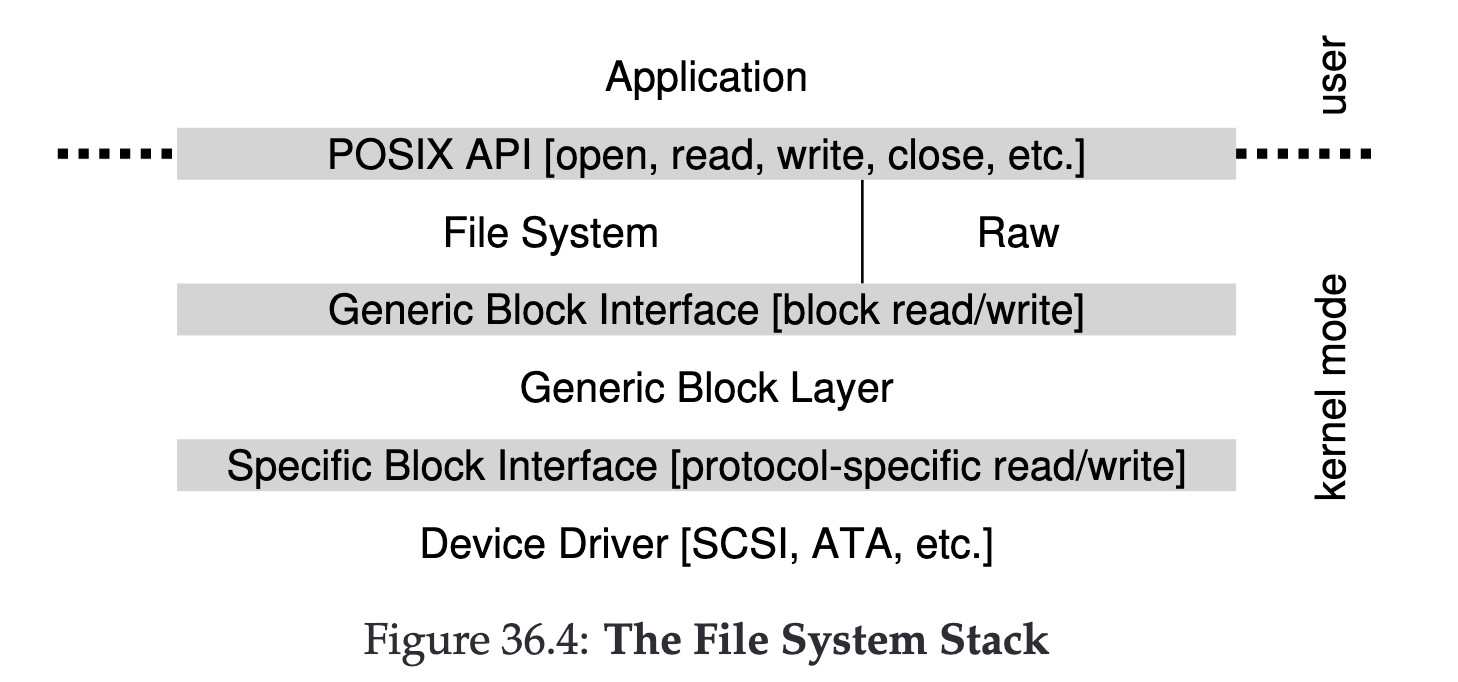Operating Systems: Three Easy Pieces Ch. 36
Input/output device (I/O)
- System Architecture
- Hierarchiacal structure
- CPU, memory, memory BUS
- I/O bus
- PCI
- Peripheral Component Interconnect
- High-speed I/O devices such as graphics
- Peripheral bus
- Lower speed bus
- SATA, USB
- connects to disks, mice, keyboards
- PCI
- Reasons
- Physics, cost
- a high-performance memory bus does not have much room to plug devices and such into it
- Modern Computer system
- DMI
- Direct Media Interface
- Devices connect to the chip
- ATA → The AT Attachment
- SATA, eSATA
- USB
- Universal Serial Bus → Keyborads, Mice
- PCIe
- Peripheral Component Interconnect Express
- Higher performance → networ, NVMe(High speed)
- DMI
- Canonical Device
- Hardware interface
- present interface that allows the system software to control its operation
- All device have specified interface and protocol
- Internal structure
- specific and responsible for implementin the abstraction the devide presents to the system
- Simple device such as CPU, memroy, RAID controller
- thousands of line of firmware
- specific and responsible for implementin the abstraction the devide presents to the system
- Hardware interface
- Canonical Protocol
- Status register → current status
- Command register → to perform certain task
- Data register → pass data to device
- Four steps
- Pooling, waiting for the device is ready to receive a command
- Sending data
- Programmed I/O
- Command using command register
- OS waits for device poerform the task
- Lowering CPU overhead
- interrupt
- Instead of pooling
- Interrupt Service Routine
- Interrupt Handler
- Allows overlap of computation and I/O
- using interrupts is not always the best solution
- Interrupt is expensive, inefficient in the case of simple I/O interrupt
- Hybrid, two-phased approach
- First Poll
- After certain time, interrupt
- if a device is fast, it may be best to poll; if it is slow, interrupt
- coalescing
- device need to raise an interrupt first waits for a bit
- multiple interrupts can be coalesced into a single interrupt delivery
- Interrupt is expensive, inefficient in the case of simple I/O interrupt
- interrupt
- More Efficient Data Movement With DMA
- when using programmed I/O (PIO) to transfer a large chunk of data to a device, the CPU is once again over burdened with a rather trivial task
- Copying the data using CPU → trivial task
- Direct Memory Access (DMA)
- OS program DMA engine by telling it where the data lives in memory, how much data to copy, and which device to send it to.
- DMA is complete → raise the interrupt, and the OS knows the transfer control is completed
- when using programmed I/O (PIO) to transfer a large chunk of data to a device, the CPU is once again over burdened with a rather trivial task
- Methods Of Device Interaction
- explicit I/O instructions
- previleged instructions
- OS controls device, directly communicate with the device
- Memory mapped I/O
- the hardware makes device registers available as if they were memory locations
- OS issues a load (to read) or store (to write) the address
- The memory-mapped approach is nice in that no new instructions are needed to support it
- explicit I/O instructions
- Device Driver
- how to fit devices, each of which have very specific interfaces
- OS must know in detail how a device work
- Device Driver solve the question

- 70% of OS code is found in device drivers
- Window is high as well
- An IDE disk presents a simple interface to the system, consisting of four types of register: control, command block, status, and error
- Basic Protocol
- Wait for ready
- Write parameter to command register
- Start I/O
- Data transfer
- Handle interrupts
- Error Handling
- Basic Protocol
- Who started first?
- Not clear
- people built these early machines, it became obvious that I/O support was needed.
- Hierarchiacal structure